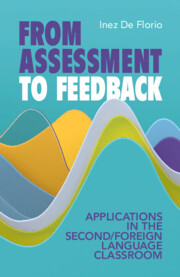Book contents
- From Assessment to Feedback
- From Assessment to Feedback
- Copyright page
- Contents
- TEFL Examples
- Introduction
- Part I Basic Concepts of Assessment and Feedback in the Foreign-Language Classroom
- Part II Assessment and Feedback in Its Different Manifestations
- 5 How to Implement Successful Feedback in Foreign-Language Teaching
- 6 Involving the Learners in Important Decisions
- 7 Feedback Is No One-Way Street
- 8 Peer Feedback Needs to Be Learned
- 9 Self-Assessment
- 10 Collegial Feedback Strengthens Language Teaching and Learning
- 11 What about Electronic Assessment and Feedback?
- 12 Remote and Hybrid Learning
- Part III Summative Assessment in Combination with Formative Feedback
- Glossary
- References
7 - Feedback Is No One-Way Street
Teachers and Learners
from Part II - Assessment and Feedback in Its Different Manifestations
Published online by Cambridge University Press: 19 January 2023
- From Assessment to Feedback
- From Assessment to Feedback
- Copyright page
- Contents
- TEFL Examples
- Introduction
- Part I Basic Concepts of Assessment and Feedback in the Foreign-Language Classroom
- Part II Assessment and Feedback in Its Different Manifestations
- 5 How to Implement Successful Feedback in Foreign-Language Teaching
- 6 Involving the Learners in Important Decisions
- 7 Feedback Is No One-Way Street
- 8 Peer Feedback Needs to Be Learned
- 9 Self-Assessment
- 10 Collegial Feedback Strengthens Language Teaching and Learning
- 11 What about Electronic Assessment and Feedback?
- 12 Remote and Hybrid Learning
- Part III Summative Assessment in Combination with Formative Feedback
- Glossary
- References
Summary
The feedback of teachers for their learners is most effective when it is based on statements of individual students, because feedback is quite often a reciprocal procedure. To obtain the possible impact, students must perceive the different forms and aspects of feedback as a help for further learning in an adequate manner. Teachers have to pay attention to the formulation, timing, and many other principles of feedback. In this context, an important asset is diagnostic assessment and the respective feedback, which should not be seen in contrast to but as a complement to learning-level assessment. Another distinction has to be made with regard to the different feedback procedures related to the content and the task, the learning processes, and the self-regulation of the learners. Hattie and colleagues show how teachers can induce the learners in different ways to give some sort of feedback about how they are able to benefit from the behavior of the teacher. This can be done at the end of a more or less extensive teaching unit.
Keywords
- Type
- Chapter
- Information
- From Assessment to FeedbackApplications in the Second/Foreign Language Classroom, pp. 107 - 123Publisher: Cambridge University PressPrint publication year: 2023

